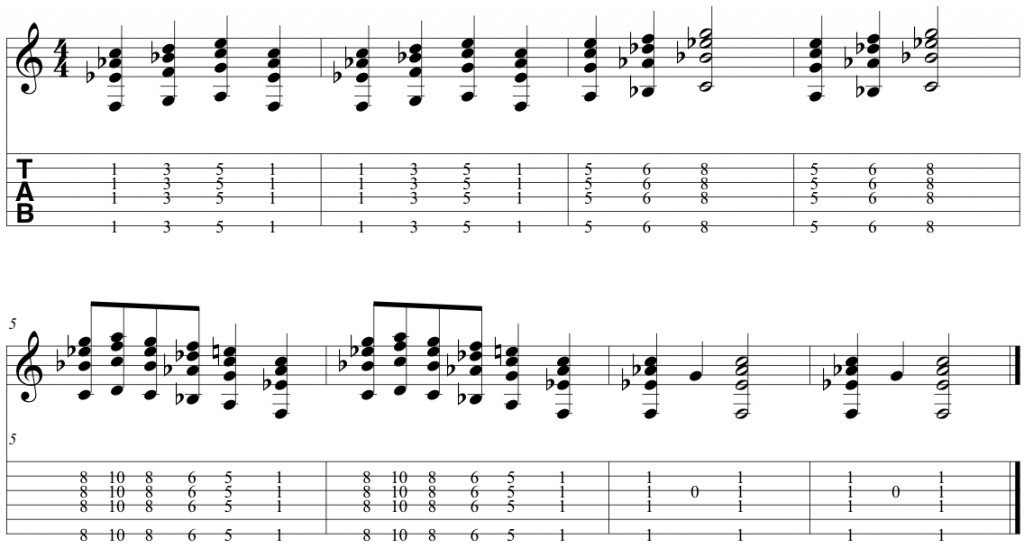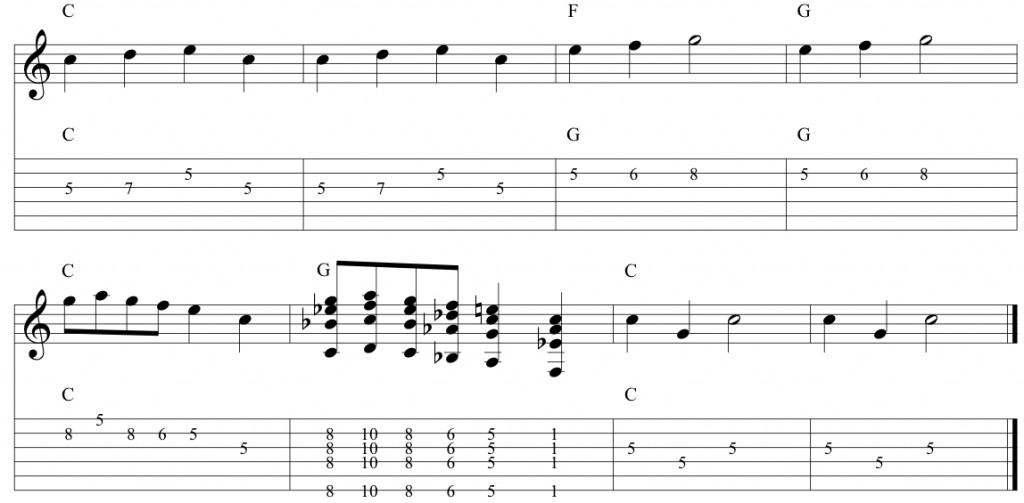What is Constant Structure?
Constant structure is a harmonization (and performance) concept in which you harmonize each individual note in a melody with exactly the same chord structure underneath each note in that melody.
In other words:
You harmonize a melody (meaning: the focus is on the melody, NOT on the chord progression), with EXACTLY the same chord structure supporting/harmonizing each individual note in that melody.
Here’s how that looks like:

Here’s a video where you can hear the above example:
Constant structure is primarily used in jazz arranging, composition, and performance.
The jazz performer, or arranger who writes an arrangement to a jazz standard, oftentimes uses constant structure to make part of a jazz melody stand out.
The gliding, parallel nature of the chord motion, makes that part of the melody where you use constant structure, more “noticeable”.
It makes the melody stand out because the sudden parallel chord motions draw attention.
Constant Structure In Songwriting.
Constant structure, when strictly adhered to as defined above, is not a tool that you can use in your songwriting, or pop or rock music.
After all: the way pop, rock, or songwriting works, is that you harmonize melodic phrases (groupings of notes) with 1 chord (or 2 chords the most) per phrase.
That is also how you harmonize melodies in jazz music of course.
The difference is that constant structure is more an arranging tool than a songwriting tool.
What this means specifically: is that the constant structure concepts are more something you would use when you, for example, arrange the melody of a pop song into say an instrumental solo guitar arrangement.
When you are writing a song, however: you typically never harmonize every individual note in your melody with a chord, but think in groupings of notes with 1 chord underneath.
Another important consideration in songwriting; is that IF you would harmonize every note in a melody with a chord, it would be more challenging for a listener to hear the lyrics and to not get distracted from the story.
There would be too much going on in the song.
Following is an example of a simple song (“Frere Jacques” again) with partial use of constant structure.

Hear the above example in the following video:
As a singer-songwriter, you would just sing the melody and strum the chords. Where the constant structure part happens, you would harmonize every melody note in your vocals with the same chord shape on every note you sing in that bar, and then go back to strumming C chords in the last 2 bars.
The following video shows how constant structure would work or how it could be used in a singer-songwriter context.
Notice how:
- That melody line that is harmonized with constant structure really stands out
- The concept does not quite sound as workable in a non-jazz context or in a singer-songwriter with vocals context.
It works, but it sounds a bit abrupt and disconnected from the rest of the song because it goes from strumming chords to suddenly hitting a chord on every melody note.
Adapt the Idea To Writing Songs
So constant structure in its true, original form, is not entirely suitable in a songwriting context.
It really is more of an arranging concept more than anything.
However: by simplifying the constant structure theory and concept, you can come up with a new approach to writing that will ignite new colors and new songs that are unlike anything you’ve ever written before.
The new approach, borrowed in part from the constant structure concept, is following:
- Rather than moving a chord shape along underneath every note of a melody: start with 1 chord of your choice.
- Then move that chord shape to a couple of different locations on the guitar neck. (For example: move the shape to 4 locations = 4 different chords with 1 shape / each chord 1 bar)
- Repeat your 4 bar chord progression and try to come up with a melody over the 4 chords.
This will prove challenging at first because you’re probably not used to writing melodies over chords that do not belong together in a scale.
However: this is a great way to improve your melodic awareness. It is also great ear training practice.
You will eventually come up with a melody that will work, and you will get a lot better at this with practice.
Challenging: Your Melody Will Combine Notes of Different Scales
Say for example that the chord you chose is Cmaj7.
There isn’t 1 scale that has 4 different maj7 chords in it.
You are no longer deriving your melody from a chosen scale.
Your melody is the result of whatever works over the chords. In other words: you adapt the melody to the chosen chords.
You are no longer deriving your chord progression from a scale: but from a chord shape that you play in x number of different locations on the guitar neck.
You probably might think to yourself now: “Random chords, no connection between the chords… I wonder if this can even sound good? This must sound like crap.”
It can lead to great-sounding songs!
The reason why this works well and indeed can sound great is because:
- The constant structure aspect (all chords being 1 same shape moved around) creates a chordal symmetry (all notes in all chords are equal distance from one another).
That symmetry creates a sense of “connectedness” between the chords. As a result: the ear “accepts” the unusual color combinations as something that “makes sense” to the ear.
- The fact that you repeat the chords 2 or 4 times in a row, makes that the ear starts feeling a “sense of familiarity” even though the chords don’t “belong to a scale together”.
For example:
Cmaj7 Gmaj7 Bbmaj7 Fmaj7
Here’s that progression transcribed:

Here’s how it sounds like with a melody added on top of the chords.
At the end: I go Abmaj7 | Bbmaj7 | Cmaj7 ||
This video should give you a pretty good idea of how this harmonic concept works in songwriting.
The example in the video also dispels the notion that this songwriting concept or maj7th chords sound jazzy.
The song idea in the video sounds much more like pop or rock than it sounds like jazz.
So yes… you can totally rock out with this constant structure-inspired songwriting technique.
You also don’t necessarily have to use this chord concept throughout the entire song.
You could have it where you use this concept in the verse, but not in the chorus, or the other way around.
I also wanted to point out, just to be clear, that this concept doesn’t work with the open string beginner’s chords.
Because of the open strings, these chords can usually only be played in a couple of locations on the guitar neck.
Some examples:
The intro to Jimi Hendrix’ “Castles Made Of Sand”
Nirvana’s “Smells Like Teen Spirit” chord progression.
Yes’s “Owner Of A Lonely Heart”.
Have fun writing new songs with this concept.
You can learn more about songwriting when you click on following titles: How To Write Chords To Your Melodies, Some Scale And Chord Theory and Understanding How Chord Progressions Work.
Conclusion
Hit me up anytime at vreny@zotzinmusic.com if you have any questions, or if you would like to book a lesson.
These free lessons are cool, but you will never experience the progress, joy, and results that my students experience in lessons when you’re learning by yourself from blogs and videos.
That is why people take lessons: way better results and progress, much more complete information, exposed to way more creative ideas than you can get from a blog or YouTube video.
There is only so much that self-study can accomplish.
If you want to see amazing results and progress in your guitar playing, buy your first lesson here and get started ASAP.
You’ll impress your friends and loved ones in no time with your guitar playing!
Consider donating any small amount to help me keep this blog going.
Thank you for your support!


